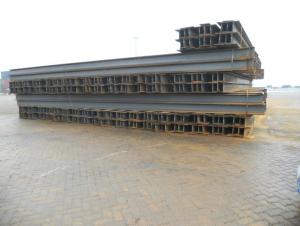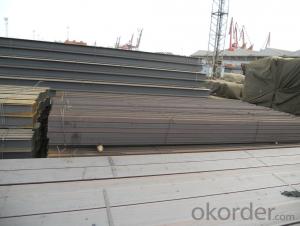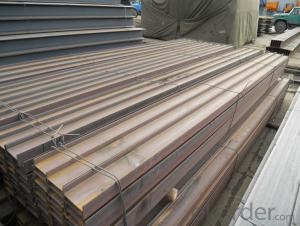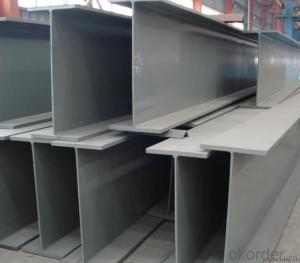Hot Rolled Structural Steel H Beam SS400
- Loading Port:
- Tianjin
- Payment Terms:
- TT or LC
- Min Order Qty:
- 100 m.t.
- Supply Capability:
- 100000 m.t./month
OKorder Service Pledge
OKorder Financial Service
You Might Also Like
Product Description:
OKorder is offering Hot Rolled Structural Steel H Beam SS400 at great prices with worldwide shipping. Our supplier is a world-class manufacturer of steel, with our products utilized the world over. OKorder annually supplies products to European, North American and Asian markets. We provide quotations within 24 hours of receiving an inquiry and guarantee competitive prices.
Product Applications:
Hot Rolled Structural Steel H Beam SS400 are ideal for structural applications and are widely used in the construction of buildings and bridges, and the manufacturing, petrochemical, and transportation industries.
Product Advantages:
OKorder's Hot Rolled Structural Steel H Beam SS400B are durable, strong, and resist corrosion.
Main Product Features:
· Premium quality
· Prompt delivery & seaworthy packing (30 days after receiving deposit)
· Corrosion resistance
· Can be recycled and reused
· Mill test certification
· Professional Service
· Competitive pricing
Product Description:
Specifications of Hot Rolled Structural Steel H Beam
1. Standard: GB700-88, Q235B2.
2. Grade: Q235, SS400 or Equivalent
3. Length: 6m,10m, 12m as following table
4. Invoicing on theoretical weight or actual weight as customer request
5.Payment: TT or L/C
Usage & Applications of Hot Rolled Structural Steel H Beam
Commercial building structure ;Pre-engineered buildings; Machinery support structure; Prefabricated structure; Medium scale bridges; Ship-building structure. etc.
Packaging & Delivery of Hot Rolled Structural Steel H Beam
1. Packing: it is nude packed in bundles by steel wire rod
2. Bundle weight: not more than 3.5MT for bulk vessel; less than 3 MT for container load
3. Marks:
Color marking: There will be color marking on both end of the bundle for the cargo delivered by bulk vessel. That makes it easily to distinguish at the destination port.
Tag mark: there will be tag mark tied up on the bundles. The information usually including supplier logo and name, product name, made in China, shipping marks and other information request by the customer.
If loading by container the marking is not needed, but we will prepare it as customer request.
4. Transportation: the goods are delivered by truck from mill to loading port, the maximum quantity can be loaded is around 40MTs by each truck. If the order quantity cannot reach the full truck loaded, the transportation cost per ton will be little higher than full load.
5. Delivered by container or bulk vessel
Production flow of Hot Rolled Structural Steel H Beam
Material prepare (billet) —heat up—rough rolling—precision rolling—cooling—packing—storage and transportation
FAQ:
Q1: Why buy Materials & Equipment from OKorder.com?
A1: All products offered byOKorder.com are carefully selected from China's most reliable manufacturing enterprises. Through its ISO certifications, OKorder.com adheres to the highest standards and a commitment to supply chain safety and customer satisfaction.
Q2: Can fit in the containers of 20fts the steel beams of 6M?
A2: No proble, we can put them into the containers in the form sideling.
Q3: The products are invoicing on theoritical weight or on actual weight?
A3: We can do it in both manners, according to the customers' request.
Images:
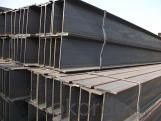
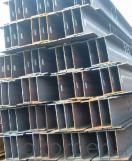
- Q:Can steel H-beams be used in the construction of religious buildings or churches?
- Yes, steel H-beams can be used in the construction of religious buildings or churches. Steel H-beams offer several advantages for construction projects, including their strength, durability, and versatility. They provide a sturdy framework that can support the weight of the structure and withstand various weather conditions. Additionally, steel H-beams can be easily fabricated and customized to fit different architectural designs, allowing for flexibility in the construction of religious buildings or churches. Their use in construction projects has become increasingly popular due to their cost-effectiveness, sustainability, and ability to meet building codes and safety requirements. Ultimately, the decision to use steel H-beams in the construction of religious buildings or churches depends on various factors, including the architectural vision, structural requirements, and budget of the project.
- Q:What are the different methods of connecting steel H-beams?
- Connecting steel H-beams in construction projects can be achieved through various methods, depending on specific requirements. Some commonly used methods include: 1. Welding: Popular for connecting steel H-beams, this method involves melting and fusing the beam edges using heat and pressure. Welded connections are strong and permanent, making them ideal for structural steel framing, bridges, and heavy-duty applications. 2. Bolting: Another common method is to secure the beams together using bolts and nuts. Bolted connections are easier to assemble and disassemble compared to welded connections, making them suitable for applications that may require future modifications or repairs. 3. Riveting: Although an older method, riveting is still used in certain applications. It involves using metal rivets to connect the steel H-beams. Riveted connections offer good strength and durability but require specialized equipment and skilled labor for installation. 4. Adhesive bonding: A modern method that utilizes structural adhesives to bond the steel H-beams, adhesive bonding is useful for achieving aesthetics and corrosion resistance. It eliminates the need for visible fasteners and provides some flexibility, allowing for joining of dissimilar materials. 5. Mechanical connectors: These pre-engineered devices offer a quick and efficient way to connect steel H-beams. They typically include plates, bolts, and other components designed for easy installation and high strength. Mechanical connectors are suitable for applications where speed and ease of assembly are crucial. The choice of connection method depends on factors such as load requirements, structural design, project specifications, and available skills and resources. It is recommended to consult a structural engineer or construction professional to determine the most suitable method for connecting steel H-beams in a specific project.
- Q:Can steel H-beams be used in the construction of shopping malls or retail buildings?
- Yes, steel H-beams can be used in the construction of shopping malls or retail buildings. Steel H-beams are commonly used in commercial construction projects due to their strength, durability, and versatility. They provide excellent structural support, allowing for open floor plans and large, open spaces often needed in shopping malls or retail buildings. Additionally, steel H-beams are cost-effective and can be easily fabricated and installed, making them a popular choice in the construction industry.
- Q:Can steel H-beams be used in seismic zones?
- Indeed, seismic zones can accommodate the use of steel H-beams. Steel is a highly favored material for seismic construction due to its remarkable strength, flexibility, and ductility. H-beams, or otherwise referred to as I-beams, offer exceptional structural support and possess the ability to endure the forces exerted during seismic events. To guarantee the secure utilization of steel H-beams in seismic zones, it is imperative to adhere to specific design and construction guidelines. These guidelines encompass various factors such as meticulously selecting the appropriate material grade, size, and shape of the beams, in addition to implementing proper connection and reinforcement detailing. Design considerations, such as the beam's moment of inertia, section modulus, and rigidity, significantly influence the beam's capacity to withstand seismic forces. Furthermore, the connections between the beams and other structural components should be designed to accommodate any potential lateral and vertical movements that may transpire during an earthquake. Compliance with local building codes and regulations that are specific to seismic zones is also of utmost importance. These codes typically outline precise design parameters, construction techniques, and material requirements that ensure structures can effectively withstand seismic activity. By diligently following these guidelines and adhering to local building codes, steel H-beams can be utilized proficiently in seismic zones, offering a secure and dependable structural solution.
- Q:Can steel H-beams be used in the construction of healthcare facilities?
- Yes, steel H-beams can be used in the construction of healthcare facilities. Steel H-beams are commonly used in structural applications due to their high strength and durability. They provide excellent support and stability, making them suitable for constructing various healthcare facility components such as walls, floors, and roofs. Additionally, steel H-beams can be easily fabricated and customized to meet specific design requirements, allowing for flexible and efficient construction. Moreover, steel is a non-combustible material, which enhances the fire safety of healthcare facilities. Overall, the use of steel H-beams in healthcare facility construction ensures a strong, safe, and long-lasting structure.
- Q:Can steel H-beams be used in earthquake-prone areas?
- Yes, steel H-beams can be used in earthquake-prone areas. Steel is a strong and durable material that is widely used in construction, especially in areas prone to seismic activity. H-beams, also known as I-beams, are commonly used in structural steel construction due to their high strength-to-weight ratio and ability to withstand heavy loads. In earthquake-prone areas, buildings need to be designed and constructed to withstand the lateral forces and ground shaking caused by seismic activities. Steel H-beams are known for their excellent resistance to bending and torsion, making them ideal for withstanding these forces. Additionally, steel structures offer several advantages in earthquake-prone areas. Steel is flexible, allowing it to absorb and dissipate seismic energy, reducing the impact on the building. Furthermore, steel structures can be designed to have ductile behavior, meaning they can deform under seismic forces without collapsing, providing a higher level of safety. It is important to note that the design and construction of steel structures in earthquake-prone areas must adhere to strict building codes and regulations. These codes specify the required seismic performance levels and design criteria that ensure the safety of the building and its occupants during an earthquake. In conclusion, steel H-beams can be safely and effectively used in earthquake-prone areas when designed and constructed according to the appropriate building codes and regulations. Their strength, flexibility, and ductility make them an excellent choice for structures that need to withstand seismic forces.
- Q:What are the design considerations when using steel H-beams in buildings?
- When using steel H-beams in buildings, there are several important design considerations that need to be taken into account. Here are a few key considerations: 1. Structural Strength: Steel H-beams are known for their high strength-to-weight ratio, making them suitable for supporting heavy loads. The design must ensure that the beams can withstand the anticipated loads without experiencing excessive deflection or failure. 2. Span and Size: The span and size of the steel H-beams are crucial factors in determining their structural integrity. The design must consider the required span length and the load-bearing capacity of the beams to ensure they can adequately support the intended load without buckling or excessive sagging. 3. Connections: Proper connection design is essential for ensuring the stability and strength of steel H-beams. The connections between the beams and other structural elements, such as columns and foundations, must be designed to transfer forces efficiently and resist any potential movement or deformation. 4. Fire Resistance: Steel H-beams are susceptible to heat, which can weaken their structural integrity. Design considerations should include fire-resistant measures, such as applying fireproof coatings or using fire-resistant insulation materials, to ensure the safety and stability of the building in case of fire. 5. Cost-effectiveness: Designers must also consider the cost-effectiveness of using steel H-beams. This includes evaluating the material costs, fabrication requirements, and construction methods associated with utilizing steel H-beams in the building design. Efficient use of materials and optimizing the beam sizes can help reduce costs while maintaining structural integrity. 6. Building codes and regulations: Compliance with local building codes and regulations is crucial when using steel H-beams in buildings. Designers must ensure that the structural design meets all relevant codes and standards, including provisions for seismic resistance, wind loads, and other environmental factors. Overall, the design considerations when using steel H-beams in buildings revolve around structural strength, size and span, connections, fire resistance, cost-effectiveness, and compliance with building codes. By carefully addressing these considerations, designers can ensure the safe and efficient use of steel H-beams in building structures.
- Q:What is the cost of steel H-beams compared to other structural materials?
- When comparing the cost of steel H-beams to other structural materials, it is evident that steel offers a competitive price. The construction industry widely utilizes steel due to its strength, durability, and versatility. While the specific cost may vary depending on factors such as size, grade, and market conditions, steel H-beams generally present a cost-effective solution for structural needs. In contrast to materials like wood or concrete, steel H-beams exhibit superior strength and load-bearing capacity. This quality allows for longer spans and fewer supporting columns, resulting in cost savings in terms of materials, labor, and construction time. Moreover, steel possesses high resistance to environmental factors like moisture, fire, and pests, consequently reducing long-term maintenance costs. Despite the potential fluctuations in steel prices due to market conditions, it remains a favored choice for structural applications due to its availability and competitiveness. When considering the cost of steel H-beams, it is crucial to evaluate other factors such as project requirements, design considerations, and overall budget to determine the most suitable and cost-effective solution.
- Q:How do you calculate the deflection limits for steel H-beams under dynamic loads?
- Several factors must be taken into account when calculating the deflection limits for steel H-beams under dynamic loads. First and foremost, determining the type of dynamic load that the H-beam will endure is crucial. Dynamic loads can be classified into two primary types: impact loads and vibration loads. Impact loads typically arise from sudden and intense forces, such as a falling object, whereas vibration loads result from repetitive or oscillatory forces, such as machinery or wind. Subsequently, it is necessary to have knowledge of the beam's material properties, including the Young's modulus (E) and the moment of inertia (I). These properties provide insight into the beam's stiffness and its resistance to bending. Once the dynamic load type and material properties are known, various methods can be employed to establish the deflection limits. The most common approach involves calculating the maximum allowable deflection based on the beam's maximum permissible stress. This is often expressed as a percentage of the beam's span or a specific limit in millimeters. Another method entails calculating the beam's natural frequency. By ensuring that the dynamic load's frequency is significantly lower than the beam's natural frequency, excessive deflection can be prevented. This approach is especially important when dealing with vibration loads. Furthermore, it is essential to consider any applicable design codes or standards that govern the deflection limits for steel H-beams under dynamic loads. These codes provide guidelines and incorporate safety factors to ensure the beam's structural integrity. It is worth noting that expertise in structural engineering principles is necessary when calculating deflection limits for steel H-beams under dynamic loads. Therefore, it is advisable to consult a qualified structural engineer or refer to established design codes to ensure accurate and safe calculations.
- Q:Are steel H-beams resistant to termites or other pests?
- Steel H-beams possess a remarkable resistance against termites and other pests. Unlike wooden beams, steel does not serve as a food source for these pests, thus making it a superb selection for structural components in buildings. Steel beams lack any nutritional value or cellulose content that would attract pests, guaranteeing their immunity to termite infestations or other issues related to pests. Moreover, steel is also impervious to rotting, warping, and decay, ensuring the longevity and durability of the structure. Consequently, steel H-beams emerge as a dependable and pest-resistant alternative for construction ventures.
1. Manufacturer Overview |
|
|---|---|
| Location | |
| Year Established | |
| Annual Output Value | |
| Main Markets | |
| Company Certifications | |
2. Manufacturer Certificates |
|
|---|---|
| a) Certification Name | |
| Range | |
| Reference | |
| Validity Period | |
3. Manufacturer Capability |
|
|---|---|
| a)Trade Capacity | |
| Nearest Port | |
| Export Percentage | |
| No.of Employees in Trade Department | |
| Language Spoken: | |
| b)Factory Information | |
| Factory Size: | |
| No. of Production Lines | |
| Contract Manufacturing | |
| Product Price Range | |
Send your message to us
Hot Rolled Structural Steel H Beam SS400
- Loading Port:
- Tianjin
- Payment Terms:
- TT or LC
- Min Order Qty:
- 100 m.t.
- Supply Capability:
- 100000 m.t./month
OKorder Service Pledge
OKorder Financial Service
Similar products
New products
Hot products
Hot Searches
Related keywords
